It’s been some 5 years since I wrote my last “Optics basics” post! The goal of that series of posts was to introduce some of the most fundamental concepts in optics in a non-technical way, in part so I wouldn’t have to constantly reexplain them in more advanced posts.
I’ve covered most of the topics that I would truly call “basic” — hence the long time since the last post — but I realized that I missed one concept that is truly fundamental: the law of reflection!
It may not seem like there’s much to say about reflection, but we’ll see that isn’t the case. Many interesting things can happen when light reflects off of a surface — the challenge will be to include as many as possible while keeping this post short!
So what is the law of reflection? Well, the classic law of reflection states that the angle that a ray of light reflects off of a smooth, flat surface (the angle of reflection ) is equal to the angle at which the light is incident upon the surface (the angle of incidence
).
I note that this applies to a smooth surface. It applies to light reflecting off of a sheet of glass or a mirror, but not light reflecting off of many other surfaces, such as a painted wall. In the latter case, the roughness of the surface makes the light bounce off in many directions — this case is known as diffuse reflection. The more familiar case of light bouncing off of glass is known as specular reflection, and when people talk of the “law of reflection,” this is what they are typically referring to. It is specular reflection that this post will be mainly concerned with, though we will say a few words about diffuse reflection at the end.
The law of reflection was the first quantitative law of light propagation discovered, and stretches back to antiquity. Who, exactly, formulated the law in writing first is unknown, though authors who have made mention of it include Euclid (c. 300 BCE), Aristotle (384-322 BCE), and Hero of Alexandria (10 CE – 70 CE).
Even these early authors recognized the use of it in designing image-forming systems. We have noted that the law of reflection applies to smooth surfaces, and this includes curved surfaces, like a mirror with a spherical shape. Locally, such a spherical mirror is flat, just as the Earth appears flat when one is standing on it, so the law of reflection applies locally at every point of the curved surface.
This is illustrated below, to show some of the image-forming properties of a spherical mirror. Two rays are drawn from the object — represented by an upright arrow — to the image, which ends up being inverted.
This is a simple illustration of graphical ray tracing: in order to find the position and size of an image, one can draw two rays to find where they intersect at the image. The two easiest rays to draw are the one that runs horizontally, and reflects through the focal point f, and the the one that passes through the focal point and reflects horizontally. The point C, incidentally, is the center of curvature of the mirror, and the focal point is half of this distance.
Images can, of course, also be formed using lenses, which use refraction to form an image, but lenses have one notable disadvantage: the location of the image depends on the color of the light. The result is what is known as chromatic aberration — the image for red light is at a slightly different position than the image for blue light — and it limits the image-forming resolution of the lens. This chromatic aberration arises because the law of refraction, given by
,
depends on the refractive indices and
, which are themselves dependent on the frequency (color) of the light. The law of reflection is the same for all frequencies, and so images from mirrors do not suffer from chromatic aberration.

The law of refraction, illustrated. Light going from a “rare” medium to a “dense” medium gets bent towards the perpendicular to the surface.
Now that we’re talking a bit about refraction (and reminder that I have a basics post on that, too), there are a number of interesting aspects of reflection that are intimately associated with refraction. Reflection and refraction, in essence, go hand-in-hand: when light hits a transparent surface, some fraction of the incident light is reflected, some is refracted. What is interesting, however, is that the amount of light reflected depends on the polarization of light.
For those unfamiliar, light is a transverse wave: that is, the electric field E and magnetic field H that make up a light wave oscillate in a direction perpendicular to the direction the wave is going. This is illustrated below (and I’ve written a basics post about it, of course).
When we describe the reflection and refraction of light at a surface, we can consider two distinct cases: the case for which the electric field lies in the plane of reflection and the case for which the electric field lies outside this plane, as illustrated below.
It turns out, in general, that the in-plane polarized light gets reflected less, and refracted more, than the out-of-plane light. You can actually see this by using a polarizer to look at car windshields on a sunny day.
This effect is of practical importance for a number of reasons. First, if you want to design polarized sunglasses, you would like them to reduce the amount of glare that one sees from reflection off of, for example, car windshields. Since more light gets reflected from the out-of-plane polarization, one designs polarized sunglasses to block that horizontally polarized light!
At one special angle, known as the Brewster angle, the in-plane light is in fact not reflected at all: it is totally refracted into the second medium. This means that, if unpolarized light (with an equal mixture of in-plane and out-of-plane) is incident on a surface at the Brewster angle, the light that is reflected will be entirely out-of-plane polarized: the in plane polarized light will be completely transmitted. This is illustrated below.
In the 1800s, this technique was the way in which most optics researchers produced a polarized beam of light. For example, Michael Faraday used it to demonstrate a link between light and magnetism in 1845.
But why is no in-plane light reflected at the Brewster angle? The answer appears in the image above. We may imagine the reflected ray is created by the incident ray interacting with the medium, resulting in reflection and refraction. But the refracted ray is perpendicular to the reflected ray, which means that the electric field of the refracted ray is parallel to the reflected one! However, as we noted earlier, light is a transverse electromagnetic wave, which means it must have an electric field oscillating perpendicular to the direction of travel. This doesn’t exist at the Brewster angle, and there is therefore no reflection.
So far, we have been looking at reflection and refraction when light goes from a “rare” medium (like air) to a “dense” medium (like water, or glass). But, of course, light can travel in the other direction, as well. When it does, another unusual reflection effect can occur, known as total internal reflection.
I discussed this in my basics post on refraction, but it is worth reiterating in short here. The law of refraction is reversible — that is, it works whether you consider the light to be coming from medium 1 or medium 2. In going from a rare medium to a dense medium, the 90° worth of incident angles are represented by a smaller range of refracted angles, as shown below.

The red shading indicates the region from which all possible incident rays appear, as well as the region of all possible refracted rays.
But what happens if we send a ray from medium 2 into medium 1, but from an angle outside of those shaded? For instance, consider the ray below: how does it refract?
The answer: it doesn’t! The angle falls outside of those for which we can use the law of refraction, and it turns out that the ray is completely reflected; we therefore call it total internal reflection.
This total internal reflection forms the basis of fiber optics, in which light is used to convey information through a long, thin glass fiber. In a simplistic way, we may imagine that the light rays travel from one end of the fiber to the other by multiple total internal reflection bounces. Of course, fiber optics is a major part of our internet infrastructure, and it is in a sense all due to a humble reflection property!
Total internal reflection can be used for quite spectacular demonstrations; as I’ve discussed previously, one can use it to guide light in a falling stream of water, in a demonstration that dates back to Jean-Daniel Colladon in 1842.
One other surprise arises from total internal reflection. It was noted in 1943 by Fritz Goos and Hilda Hänchen that a beam of light, totally internally reflected, actually shifts along the surface before being reflected! After multiple reflections, this Goos-Hänchen shift can accumulate and become quite large. The illustration below is from their original paper, showing how a beam of light multiply reflected within a piece of glass ends up with a very large shift.
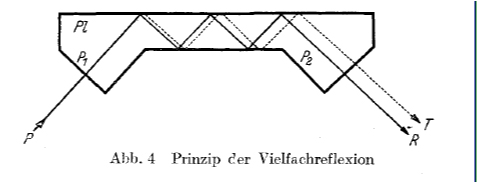
Figure showing the use of multiple reflections to measure the Goos-Hanchen shift, from their original paper.
Why does light, in essence, “creep” along the surface before reflecting? Well, you’ll have to read the blog post I wrote about the effect last year.
There’s one other curious effect worth mentioning before we conclude. We have, so far, considered only specular reflection; that is, reflection off of a smooth surface. Most surfaces, however, are not smooth, and a beam of light shining off of them ends up bouncing off of the surface irregularities and going in all directions, as shown in the image below, from Wikipedia.
This is why, for instance, the walls of your house do not look like mirrors: the roughness of the painted surface disrupts the reflection. Curiously, though, it has been known for well over a hundred years¹ that certain rough surfaces can also produce specular reflection, provided one looks at light incident from a very large angle!
It takes a surface with juuuuust the right roughness to make this effect work, but you can a actually see it in action pretty well with an ordinary sheet of paper! Below, I look at a piece of paper from an ordinary angle, and then tilt it and look at a lamp from a very grazing angle. In the latter case, you can (somewhat) see the reflected image of the lamp beyond.
Why would this work? It’s a bit tricky to explain, but we’ll give it a try! A lightwave, like the electromagnetic wave we drew earlier, has a characteristic wavelength associated with it. This wavelength is, literally, the spatial distance between two peaks of the wave. When light encounters structures smaller than the wavelength of light — for example a rough surface with surface variations smaller than the wavelength — it doesn’t “see” those variations.
This is why specular reflection exists at all, in fact. All surfaces have some degree of roughness, as they are all made out of atoms, but “smooth” surfaces like metals have roughness much smaller than the wavelength.
Now consider the illustration below. We first draw a normally incident wave, with the rays drawn a wavelength apart from each other for clarity. This wave encounters a surface where the variations also are about the size of the wavelength: the light wave will therefore “see” these variations and be scattered in all directions.
Now imagine that we shine the lightwave on the surface from an angle. The actual perpendicular distance between the rays is the same as before, but the horizontal distance between the rays is much, much larger. It turns out that this effective wavelength is now bigger than the size of the roughness — in this case, the wave no longer “sees” the roughness!
This explanation may seem a bit incomplete, and it is, but it is about as good as we can do without diving into the math in some detail.
At this point, this blog post is over 2000 words, which means it’s probably a good time to wrap it up. There is, as we have seen, a surprising amount that can be said about the simple process of reflection! Something to reflect upon…
*********************************************
¹ For instance, there is the paper by T.K. Chinmayanandam, “On the specular reflection from rough surfaces,” Phys. Rev. 13 (1919), 96. He, however, talks about work by Lord Raleigh and others. It seems like an effect that was noticed by many people over the years and has no definite discoverer — somewhat like the law of reflection itself.

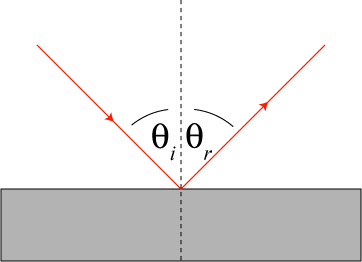

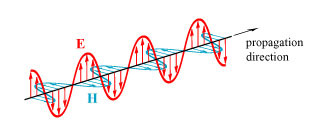
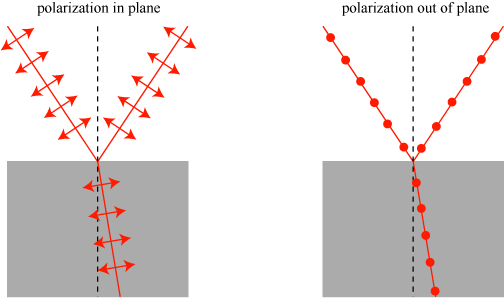





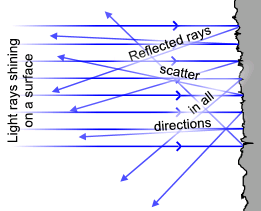

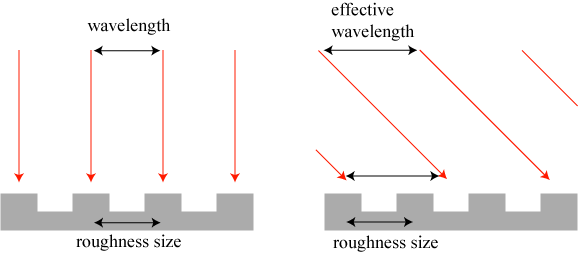

Great post, I’d never heard about that effect of getting specular reflection on a rough surface when viewed at an oblique angle but that’s really interesting!
It reminds me of something that fascinated me enough to write about it a couple of years ago, which is the way reflections of bright objects appear to be stretched vertically when viewed over a rough surface like a wet road or the ocean.
When I was looking into it, I feel like I mostly figured out why it happened, but I can’t say I’m entirely sure I fully understand it. I’ve got this nagging feeling I’m still missing something too – in some conditions the vertical stretching just seems too extreme for what I think I’d figured out as the reason.
I was wondering if you might be familiar with why these reflections always seem to be stretched vertically (at least, when the reflecting surface is horizontal) rather than just being blurry in general?
(Here’s a link to the first of two posts I wrote about it if you’re interested: http://sciblogs.co.nz/honestuniverse/2015/06/09/natural-curiosity-stretching-reflections/)
Not sure about that effect — will have to ponder it!
Thank you very much. I have to say, I have learnt a couple of things (at least in an intuitive sense). By the way, should the word be “reflection” in the sentence “…The law of refraction is the same for all frequencies, so images from mirrors do not suffer from chromatic aberration.” just above the third figure?
Fixed — thanks!